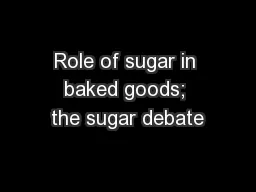PPT-Role of sugar in baked goods; the sugar debate
Author : debby-jeon | Published Date : 2016-07-19
Gary Tucker Baking and Cereal Processing Department Campden BRI Content Controversy with sugar Functionality of sugar Sugar alternatives The future Chipping Campden
Presentation Embed Code
Download Presentation
Download Presentation The PPT/PDF document "Role of sugar in baked goods; the sugar ..." is the property of its rightful owner. Permission is granted to download and print the materials on this website for personal, non-commercial use only, and to display it on your personal computer provided you do not modify the materials and that you retain all copyright notices contained in the materials. By downloading content from our website, you accept the terms of this agreement.
Role of sugar in baked goods; the sugar debate: Transcript
Download Rules Of Document
"Role of sugar in baked goods; the sugar debate"The content belongs to its owner. You may download and print it for personal use, without modification, and keep all copyright notices. By downloading, you agree to these terms.
Related Documents














